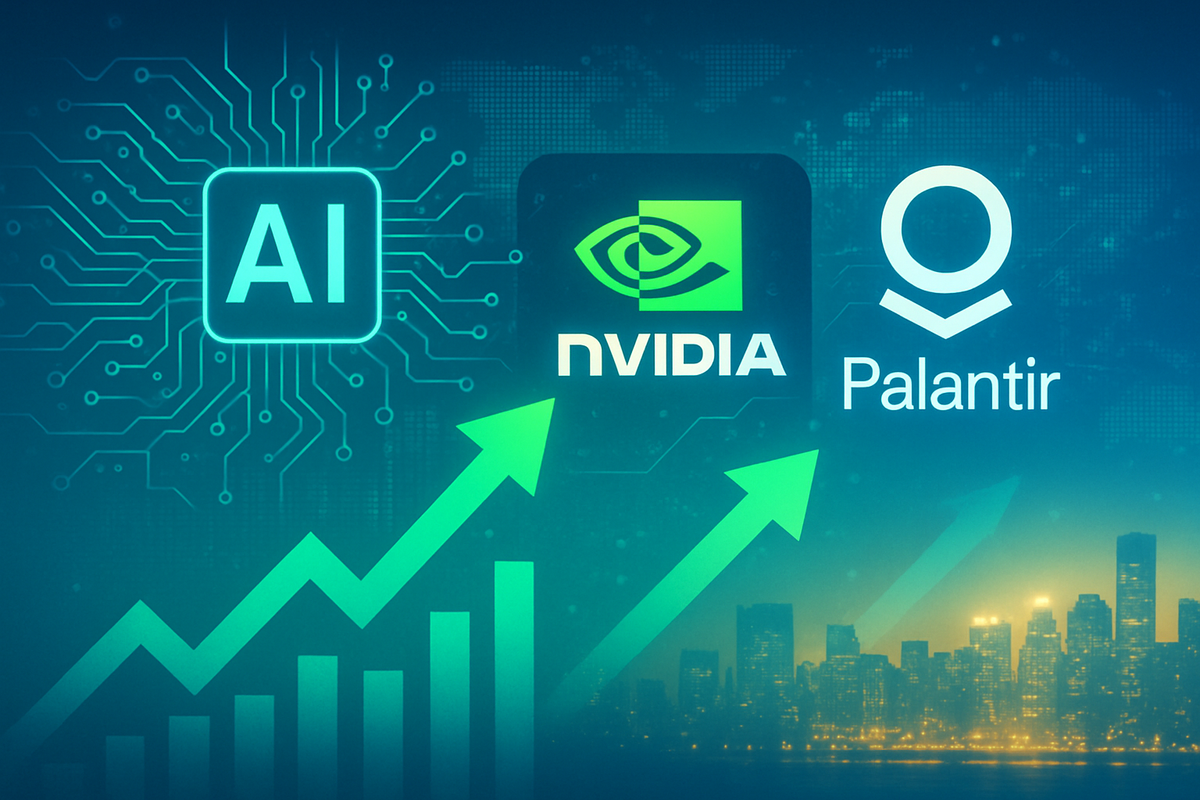
October 5, 2025 – Dow Jones Industrial Average futures are charting a robust upward trajectory, signaling a bullish start to trading as investors eagerly anticipate continued monetary easing from the Federal Reserve and maintain an insatiable appetite for artificial intelligence (AI) innovation. This market optimism is particularly palpable around key tech players like Nvidia (NASDAQ: NVDA), widely perceived to be in a "buy zone," and Palantir Technologies (NYSE: PLTR), which appears poised for a significant rebound. These movements collectively underscore a market grappling with both technological transformation and evolving central bank strategies, with profound implications for the broader economy.
The current surge reflects a complex interplay of factors, including softer economic data that has bolstered expectations for Federal Reserve interest rate cuts, and an unrelenting rally in AI-related stocks. Despite lingering concerns over market concentration and geopolitical uncertainties, the prevailing sentiment is one of resilience and growth, driven by the transformative potential of AI and a supportive monetary policy environment.
The Undercurrents of a Bullish Market: AI, The Fed, and Economic Shifts
The sustained rise in Dow Jones futures is a culmination of several powerful market-moving forces, shaping investor sentiment and driving strategic positioning across industries. A timeline of general market progression leading to this moment reveals a dynamic interaction between macroeconomic indicators, central bank decisions, and technological breakthroughs.
In recent months, market participants have closely monitored economic data, which, when showing signs of moderation or weakness (such as softer labor market reports or declining manufacturing indices), has paradoxically fueled market rallies. This is because such data often increases the likelihood of central banks adopting a more accommodative monetary policy. Indeed, expectations of Federal Reserve interest rate cuts have been a significant tailwind, as lower rates typically reduce borrowing costs for corporations, stimulate economic activity, and make equities more attractive relative to bonds. The market has priced in a high probability of further rate reductions, creating a favorable liquidity environment for risk assets.
Simultaneously, the relentless march of technological innovation, particularly in Artificial Intelligence, has been a dominant theme. The AI revolution is not merely a sector-specific phenomenon but a fundamental shift driving productivity gains and creating new business models across the economy. News of breakthroughs in generative AI, new product launches, and robust earnings from leading AI companies have consistently ignited investor enthusiasm. This technological momentum has created a self-reinforcing cycle, where optimism about AI's transformative power drives investment, which in turn fuels further innovation and market gains.
Key stakeholders in this environment include central banks, particularly the Federal Reserve, whose policy pronouncements are meticulously scrutinized for clues on future rate decisions. Institutional investors, hedge funds, and retail traders are all actively positioning themselves to capitalize on these trends, using futures markets as an early indicator of market direction. Corporations, especially the constituents of the Dow Jones Industrial Average, influence the index through their earnings performance and strategic investments. The initial market reaction to these converging trends has been overwhelmingly bullish, with futures often signaling upward movements before the traditional trading day begins, reflecting widespread anticipation of continued growth.
Nvidia and Palantir: Bellwethers of the AI-Driven Economy
The current market rally is particularly illuminated by the strong performances and optimistic outlooks for companies at the forefront of the AI revolution, notably Nvidia and Palantir. These companies exemplify the significant opportunities emerging from the integration of advanced data analytics and artificial intelligence across various sectors.
Nvidia (NASDAQ: NVDA): The Indispensable AI Enabler in a "Buy Zone"
Nvidia is widely considered to be in a "buy zone" due to its indispensable and dominant role in the AI and semiconductor industries. The company's Graphics Processing Units (GPUs) are the computational backbone for training complex AI models, deep learning, and powering data centers globally. Its proprietary CUDA software ecosystem provides a critical competitive moat, tightly integrating hardware and software to create an industry-standard platform for AI development.
Nvidia's financial performance has been exceptional, characterized by robust revenue growth, high profitability margins, and strong earnings growth expectations. This is fueled by insatiable demand for AI technologies across diverse applications, from autonomous vehicles to advanced robotics. Analysts maintain overwhelmingly optimistic ratings, with many projecting continued substantial upside. Furthermore, strategic diversification into data center networking, enterprise AI solutions, and physical AI applications, coupled with increased accessibility post-stock split, reinforces its appeal. Nvidia's technological leadership and comprehensive AI platform ecosystem position it as a foundational player in the ongoing AI revolution, making it a compelling investment for those betting on AI's long-term trajectory.
Palantir Technologies (NYSE: PLTR): Eyeing a Rebound Driven by AIP and Government Contracts
Palantir Technologies (NYSE: PLTR) is strategically positioned for a rebound, primarily driven by the explosive growth and adoption of its Artificial Intelligence Platform (AIP) and its stable, high-value government contracts. AIP, launched in early 2023, has become a significant growth engine, particularly in the commercial sector, enabling organizations to rapidly deploy AI-driven solutions and significantly boost productivity. The company has seen surging U.S. commercial revenue, rapid customer acquisition, and successful "bootcamps" that accelerate client integration. Real-world examples, such as Walgreens and Heineken leveraging AIP for dramatic operational efficiencies, highlight its tangible impact.
Complementing its commercial success, Palantir's robust portfolio of government contracts provides a stable revenue foundation. High-profile deals with entities like the U.S. Army, Space Force, and Department of Defense for battlefield intelligence and data platforms underscore its critical role in national security and defense. These long-term contracts, often with high-level security clearances, offer predictability and a significant competitive advantage. Palantir has also demonstrated a strong financial turnaround, achieving consistent GAAP profitability, accelerating revenue growth, and generating robust free cash flow. While valuation concerns persist due to its high multiples, the company's expanding AI platforms, entrenched government relationships, and improving financial health position it for continued investor interest and a potential upward trajectory.
Wider Significance: A New Economic Paradigm and Emerging Challenges
The market rally, propelled by AI and tech stocks amidst expectations of central bank easing, signifies a profound shift towards a new economic paradigm. This is not merely a cyclical upturn but a structural transformation, often likened to a new industrial revolution.
This event fits into broader industry trends of accelerated digitalization, automation, and data-driven decision-making. AI acts as a hyper-accelerant, pushing industries from healthcare to finance to integrate advanced analytics and machine learning into their core operations. This has led to massive capital expenditure in AI infrastructure, benefiting ancillary markets like industrial manufacturing, energy, and cybersecurity. The global race for AI dominance is also intensifying, with nations heavily investing in domestic capabilities.
The ripple effects are extensive. For competitors, the imperative to adopt AI to remain relevant is stark; those slow to adapt risk obsolescence. Smaller tech firms without substantial capital or resources may struggle to keep pace with well-funded giants, potentially widening the gap between market leaders and laggards. For partners, new avenues for collaboration are emerging, often centered around AI model training, deployment, and integration, creating an interconnected ecosystem where companies like Nvidia are foundational.
However, this rapid advancement also brings significant regulatory and policy implications. Concerns about market concentration are growing, with a few dominant players consolidating power in the AI ecosystem, raising antitrust questions. Governments worldwide are grappling with the ethical implications of AI, including data privacy, algorithmic bias, and safety, leading to calls for new regulations. The potential for job displacement due to AI-driven automation is a major societal concern, prompting discussions on workforce retraining and the future of labor. Geopolitical tensions, particularly around chip technology and AI capabilities, are also driving national security policies and export controls.
Historically, comparisons are often drawn to the dot-com bubble of the late 1990s. While both eras share a sense of market exuberance and concentrated gains in tech stocks, there are key differences. Today's AI leaders are generally highly profitable, cash-rich companies with tangible earnings, unlike many of the revenue-scarce startups of the dot-com era. However, the unprecedented concentration of market gains in a handful of mega-cap stocks remains a point of caution, prompting some experts to warn of an "early-stage bubble" if the massive AI investments don't translate into proportional revenue growth across the broader market.
What Comes Next: Navigating a Transformative Landscape
The market's trajectory in the coming months and years will be defined by the continued evolution of AI and the strategic adaptations of central banks. In the short term (next 1-2 years), the market will likely see ongoing AI adoption alongside a gradual unwinding of restrictive monetary policies. The Federal Reserve is anticipated to continue with interest rate cuts, moving towards a more neutral stance to achieve a "soft landing." AI's immediate impact could be disinflationary through productivity gains, though this may evolve into moderate inflationary pressures as AI-related demand increases.
Longer term (beyond 2 years), AI is expected to significantly elevate global output, consumption, and investment, leading to a higher path of potential economic growth. This could, in turn, exert upward pressure on the natural rate of interest. Central banks will face the complex task of managing AI's influence on inflation, potentially needing to adjust policies if AI-driven demand outstrips supply-side gains. The benefits of AI may also be unevenly distributed, potentially increasing economic inequality if gains accrue predominantly to capital owners.
Strategic Adaptations:
- For Companies: Prioritize investment in AI infrastructure, talent, and workforce reskilling. Business models must be re-evaluated and reinvented to embed AI, focusing on data strategy, governance, and strategic partnerships. Agility will be paramount.
- For Investors: Adopt dynamic strategies, balancing short-term monetary policy impacts with AI's long-term transformative effects. This includes sector rotation towards high AI adoption potential, risk diversification, and utilizing AI-powered investment tools. A focus on fundamentals, with an AI lens, will be crucial.
Market Opportunities: Niche AI applications, cybersecurity, sustainable technologies, and specific industries like healthcare, banking, and automotive are poised for significant growth. Generative AI will unlock new value in customer operations, marketing, and R&D.
Market Challenges: Data privacy and security concerns, algorithmic bias, potential job displacement, and regulatory hurdles will require careful navigation. Systemic financial risks from over-reliance on a few AI providers or homogeneous AI algorithms could amplify market volatility.
Potential Scenarios: Outcomes could range from a "soft landing" with managed disinflation, where AI contributes to sustained non-inflationary growth, to inflationary pressures necessitating further rate hikes. More challenging scenarios include "stagflation" or increased market concentration and inequality. Financial instability from unforeseen AI risks also remains a possibility, demanding proactive central bank intervention.
Wrap-up: A Market in Transformation
The current market environment, as of October 5, 2025, is defined by the powerful convergence of AI-driven growth and evolving central bank policies. The soaring Dow Jones futures, alongside the strong performances of companies like Nvidia and Palantir, underscore a period of profound technological transformation that is reshaping industries and investment landscapes.
Key Takeaways: AI is the undisputed primary catalyst for market dynamics, driving unprecedented highs in major indices, albeit with significant concentration in a few tech giants. Central banks, particularly the Federal Reserve, are navigating a complex path of gradual interest rate cuts to achieve a "soft landing," contrasting with divergent policies globally. This creates a delicate balance between fundamental strengths and speculative exuberance.
Market Moving Forward: The market will continue to be characterized by "structured volatility," with record highs coexisting with underlying caution. AI is projected to deliver sustained productivity growth and reshape labor markets, but the sustainability of current valuations hinges on AI investments translating into proportional revenue growth across the broader economy. The lasting impact will be seen in redefined business models, increased productivity, and a re-evaluation of traditional investment strategies.
What Investors Should Watch For: In the coming months, investors must closely monitor corporate earnings, especially outside the dominant tech sector, to gauge the breadth of economic growth. Federal Reserve communications on interest rate policy and global economic indicators will be crucial for understanding monetary policy shifts. Scrutinizing valuation metrics, diversifying portfolios, and assessing the tangible Return on Investment (ROI) from AI expenditures will be paramount. Geopolitical developments and regulatory responses to AI will also introduce significant market uncertainties.
This content is intended for informational purposes only and is not financial advice





